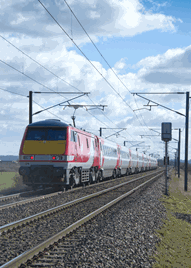 Read the peer reviews for this feature.
Read the peer reviews for this feature.
Download the graphs for this feature.
It seems we may be entering a period of possible tectonic change in the passenger rail industry. The Competition and Markets Authority’s recent discussion document for consultation, Competition in passenger rail services in Great Britain, set against the backdrop of the commissioning in the summer of the Shaw Report and the Hendy Review, signals potential evolution in the economic, commercial and regulatory model underpinning the railway industry.
The CMA’s focus on greater ‘on-track’ competition, and the impact that may have on the network, raises some interesting tensions and dilemmas - not least of which is the role that ‘on track’ competition should play going forward.
There are two limbs to this. Firstly, proponents of increased ‘on track’ competition argue that it would lead to lower prices, better services and more innovation in passenger rail services. Secondly, they also argue that ‘on track’ competition would place positive pressure on Network Rail to improve its service offering, and help it to achieve better performance across its network management and growth responsibilities.
This latter point is particularly relevant, given the major public investment in rail to increase capacity on the constrained networks, in order to meet demand and allow for growth - ERTMS, line upgrades, HS2 and new rolling stock such as IEP trains.
This investment needs to be supported by business cases and economic analysis on a case-by-case basis. But there is also the wider economy to consider, particularly the ‘Northern Powerhouse’ concept, which depends on improving the rail network in general, not just the most profitable routes into and out of London.
This leads to concerns from those who are more sceptical of the benefits of competition. They make the point that while the economic theory of enhanced competition may be good for some routes, other routes - particularly those that are unprofitable but socially valuable - would suffer in practice, and that this would have a long-term negative impact on railways overall.
In particular, a focus on simply driving down fares and promoting free competition may harm investment, and prevent the delivery of the required network benefits that are necessary to sustain the rail industry and capitalise on the progress made to date.
The current question is: which (if any) of the alternatives to the current market design would preserve and enhance the significant improvements made to rail passenger services over the past 20 years, and which would harm their future development?
Part of the complexity of the market is that there are different perspectives within Government. The CMA’s document reminds us that one of the roles it is sworn to deliver is to challenge Government where Government is creating barriers to competition. It is in this capacity that this consultation document has been produced, on the back of concerns that competition in the railway sector (as with other regulated sectors) could be delivering more for taxpayers and the economy.
This brings the CMA into contact with the Office of Rail and Road and Department for Transport, and their different perspectives on the rail market that have evolved in conjunction over time and while experiencing massive growth in rail passenger journeys and rail passenger satisfaction scores since privatisation - mostly achieved through ‘off track’ (franchise) competition.
One might therefore question why the CMA feels the need to get involved at all, given this record of achievements. However, it is clear that the rail network itself remains significantly challenged in delivering the necessary infrastructure for the railway network to flourish (note the Shaw and Hendy reviews referred to above). And there are arguments that where open access operators (OAOs) have been running services it has led to significant improvements for passengers - not just on their services, but also on the competing franchise services, which have been forced to keep up.
While actual changes may be some years away (with the CMA talking about 2023 onwards), the policy views that will shape those changes seem to be starting to come into focus now. In this period of consideration, it will be important for all stakeholders to consider the effects of changes carefully, to ensure that any changes made are for the benefit of the consumers, taxpayers and the economy in general and do not result in negative unintended consequences.
DfT: Political objectives
The role of central Government has developed over time. At privatisation, the original intention expressed in the 1992 White Paper was for franchises to be designed wherever possible to provide scope for competition between franchise operators. This included the intention that ‘on track’ competition would be moderated, but only to a limited extent and only for a transitional period.
The arrival of a Labour government in 1997 and the creation of the Strategic Rail Authority meant that from 2002 new franchises were specified much more closely, with much more tightly specified timetables.
There was also a priority to have a single operator for each London terminus, as it was believed that this would assist with network capacity usage. This can be seen as the focus shifting from competition where feasible to one where the priority was the delivery of socially desirable services cross-subsidised by more profitable routes to alleviate the burden on the taxpayer.
Since then, and following the problems with the West Coast franchise, the Brown Review recommended a number of changes take place. These have been broadly accepted by the DfT, but it remains to be seen how all of these will translate into general franchising practice.











